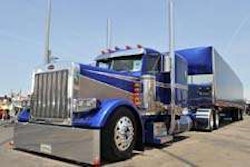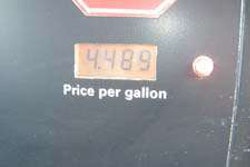Top Performer
For aerodynamic fuel economy, the Cascadia is a leader. Plus it offers maintenance ease, comfort, power and durability.
Since the introduction of Kenworth’s T600 in the 1980s, manufacturers have been refining the aerodynamics of the conventional tractor. A wind-cheating design has become critically important given that at speeds above 50 mph, the effort in pushing the wind aside is the major contributor to marginal fuel use.
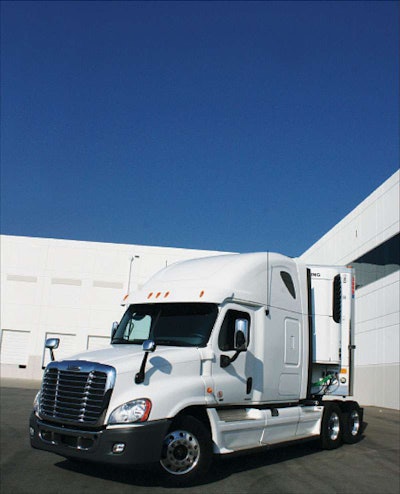 Freightliner’s Cascadia is such a familiar truck on the road that it’s hard to remember what a startling sight it was when introduced in 2007. The huge grille opening, the sculpted doors, the visorless windshield, the pedestal-mounted mirrors, the stubby side extenders – all of it was new. And all of it was the result of extensive wind tunnel tuning of a finely wrought design.
Freightliner’s Cascadia is such a familiar truck on the road that it’s hard to remember what a startling sight it was when introduced in 2007. The huge grille opening, the sculpted doors, the visorless windshield, the pedestal-mounted mirrors, the stubby side extenders – all of it was new. And all of it was the result of extensive wind tunnel tuning of a finely wrought design.To develop the Freightliner Cascadia, Daimler Trucks designed its own wind tunnel in Portland, Ore. More than 2,500 hours were spent testing and redesigning using full-size models to create the new tractor. Since then, the Cascadia has been back in the wind tunnel to make it possibly the most aerodynamic truck ever on America’s highways.
The extension of the fender line into the doors is no styling exercise, though it does make the Cascadia distinctive from the side. More importantly, flowing lines help manage the airflow along the cab and sleeper. Lately, the visor is back as an option, though it performs a useful function in helping move the air over the rooftop. Side extenders have grown a little to keep the air flowing smoothly onto the trailer sides.
From the front, with that huge grille accommodating a 1,625-square-inch radiator, you can’t miss a Cascadia. Form and function are at one: The big opening draws in as much air as possible to minimize fan-on time, in turn reducing parasitic draw on the engine and boosting fuel economy.
The Freightliner I tested featured the Detroit DD15 at 475 hp and 1,650 lb.-ft. of torque. It was backed up by an Eaton FRO-16210C 10-speed transmission.
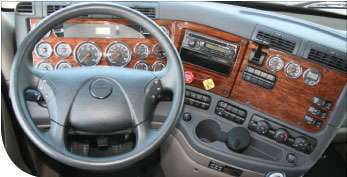 A full complement of gauges in the wood-grain dash includes the combination fuel and diesel-exhaust-fluid gauge. On the wing dash is a fuel economy gauge. Also, additional HVAC vents are there to complement those directly ahead of the driver for good ventilation and cooling. In the sleeper, doors cover the storage closets for a clean look. There are openings for the TV and microwave, with 120-volt outlets.
A full complement of gauges in the wood-grain dash includes the combination fuel and diesel-exhaust-fluid gauge. On the wing dash is a fuel economy gauge. Also, additional HVAC vents are there to complement those directly ahead of the driver for good ventilation and cooling. In the sleeper, doors cover the storage closets for a clean look. There are openings for the TV and microwave, with 120-volt outlets.It came from Los Angeles Freightliner in Fontana, Calif., on Valley Boulevard. Valley has to be one of the worst pieces of pavement anywhere, so the first surprise was how comfortable the ride was as I bobtailed to pick up a new Utility reefer. I continued to be impressed with the smooth ride as the Cascadia coped with rough concrete when I headed out I-10 westbound and then to I-15 toward the high desert.
Another excellent feature was the sporty shifter Freightliner engineered for the 10-speed. It had a close gate with short throws, but it was not in the least heavy. It was as good as a Kenworth’s, and that says a lot. Good throttle modulation meant little difficulty with the gears, whether clutching or float-shifting the transmission.
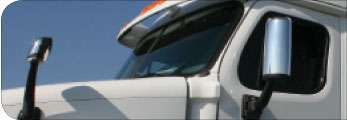 The view from the driver’s seat is excellent, with little intrusion by the big hood. For the test Cascadia, the rear view was displayed in big mirrors mounted so firmly on the doors you can actually swing on them. The result was a completely vibration-free image. The truck also featured the optional forward-mounted mirrors on the side of the hood, equally firmly mounted and showing an excellent view of the blind spots usually created with a full-width cab. A downward-looking mirror on the passenger door made assurance doubly sure.
The view from the driver’s seat is excellent, with little intrusion by the big hood. For the test Cascadia, the rear view was displayed in big mirrors mounted so firmly on the doors you can actually swing on them. The result was a completely vibration-free image. The truck also featured the optional forward-mounted mirrors on the side of the hood, equally firmly mounted and showing an excellent view of the blind spots usually created with a full-width cab. A downward-looking mirror on the passenger door made assurance doubly sure.As with all modern truck diesels, the DD15 has excellent clutch engagement torque and needs no throttle to get the truck moving. Then almost no foot-feed is necessary to get to speed. Going through low range, 900 rpm was all that was needed. Flicking the range-change up, and pulling the shift lever left and back to pick up high range, no more than 1,400 rpm was necessary to get to freeway speed.
The two-turbo design of the DD15 is not unique to American big-bore diesels, where series turbocharging has become almost commonplace. The difference with the Detroit, though, is that downstream turbo actually provides power to the flywheel through a reduction gear. The upstream turbo provides the air for the engine by way of a charge cooler. Since the downstream turbo-compound power requires its own backpressure, the engine turbocharger needs no complex variable geometry to recirculate the exhaust.
The contribution of the turbo-compounding makes an additional peak 50 hp available and the result is a real kick in the pants when you press the accelerator: The DD15 builds torque far faster than any comparable big diesel. It feels more like a 550- or 600-hp engine when you initially mash the throttle.
This also makes the DD15 a good engine for freeway overpasses that can pull down speed as you need it. With the Detroit, the response is immediate and speed is maintained.
Another impressive feature was the lack of noise. Though we admittedly tread lightly on the surface streets, there was no cab-produced noise, no booming or rattling. On the freeway, the truck settled into a quiet cruise, showing sound levels comparable with – or even a shade quieter than – the International ProStar+ and the Volvo VN.
The quiet ride, along with the multi-adjustable suspension seats, help relax the driver. A three-compartment cushion provides excellent lumbar support.
The Cascadia is all about size. It is wide and tall inside and a comfortable truck whether you’re driving or resting. The cab width allows for seats two inches wider, longer and taller. Yet even with the wide seats, there’s 24 inches of walk-through to the standard 72-inch high roof sleeper, which has 94 inches of stand-up room. The seats are on swivels so they can double as armchairs when logging off-duty sleeper time.
Another distinctive feature is the small windows in the sleeper. They don’t help with fuel economy, but they do eliminate the potential water leakage path with the conventional mounting of glass in rubber. At the launch in 2007, Freightliner said research showed drivers didn’t particularly care about seeing out of the sleeper, but they did care about others seeing in. Eliminating the lower side windows at the time seemed an easy decision. But they are back, as is a sleeper door, as an option.
The Freightliner Cascadia’s bumper is in three pieces – as is the hood – for quick and inexpensive repair. For the same reason, the huge windshield is a two-piece roped-in design. The aluminum cab is designed to withstand not just the standard ECE 29 crash test, but the far more rigorous Swedish cab test requirements.
 Contributing Editor Steve Sturgess has covered trucking, automotive and related fields for more than 30 years.
Contributing Editor Steve Sturgess has covered trucking, automotive and related fields for more than 30 years.Quick-replace items include headlamp bulbs and a low-maintenance heating and ventilation system. There is easy engine access through removable panels.
2012 Freightliner Cascadia
FRAME: Freightliner 11⁄32 by 3-1⁄2 by 10-3⁄16 inch steel, 120 ksi
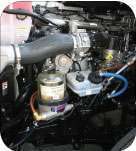 The model tested featured the Detroit DD15 at 475 hp and 1,650 lb.-ft. of torque.
The model tested featured the Detroit DD15 at 475 hp and 1,650 lb.-ft. of torque.ENGINE BRAKE: Jacobs
TRANSMISSION: Eaton Fuller FRO16210C, 10-speed O/D
WHEELBASE: 225 inches
FRONT AXLE: Detroit DA-F12,000-lb. dual taper-leaf suspension
REAR AXLE: Detroit DA-RT-40 40,000 lbs., 3.42:1
SUSPENSION: FreightlinerAirliner 40,000-lb. air-ride
WHEELS: Accuride hub pilot, outside polished
FUEL TANKS: Dual 120 gallons, unpolished
FIFTH WHEEL: Holland FWS1
OTHER: Freightliner heated, motorized mirrors; hood mirrors; full aerodynamic package; AM/FM/CD weatherband radio with MP3 player interface; automatic temperature control HVAC; 160-amp alternator; Borg Warner on/off fan clutch; Delco 69MT starter; Davco 482 fuel/water separator; ConMet pre-set aluminum hubs; Virtual Technician diagnostics.


